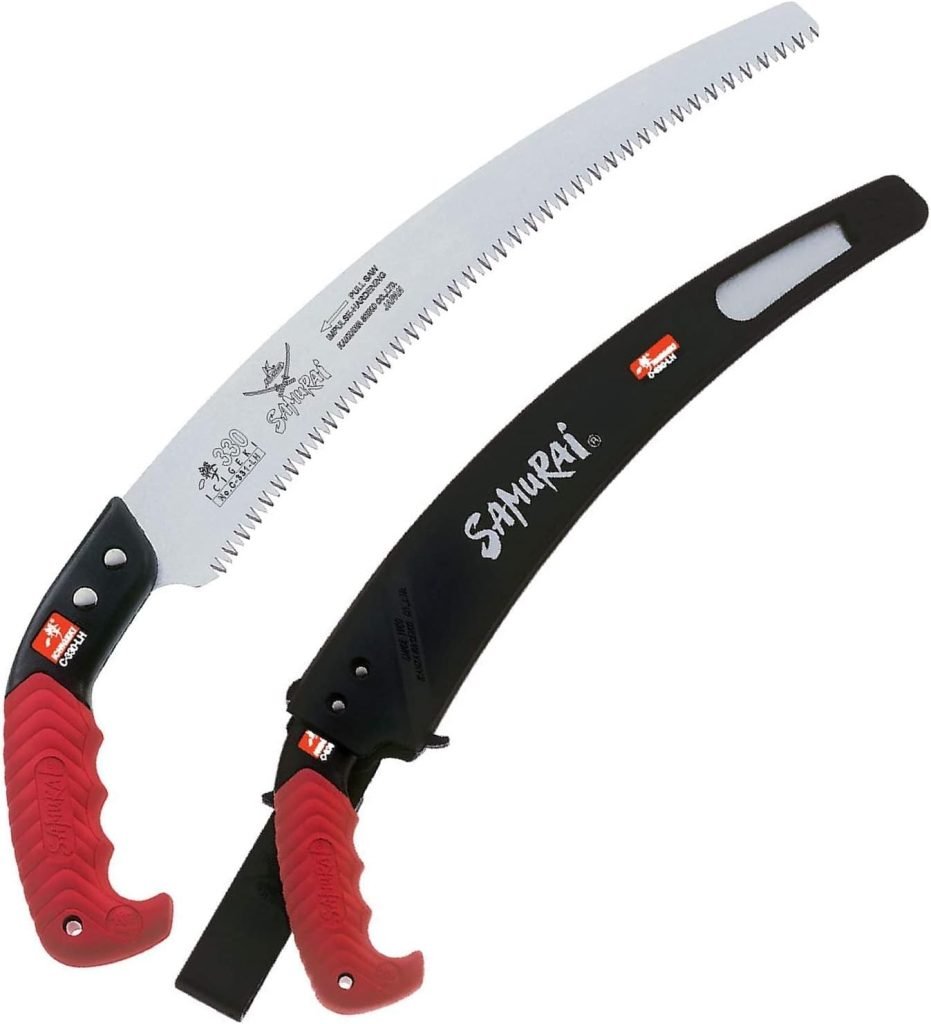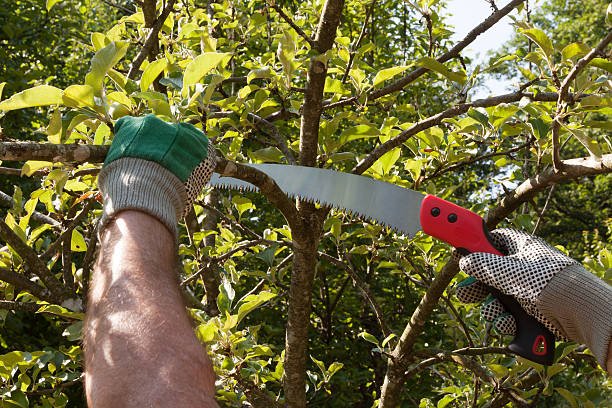A pruning saw is a specialized tool for cutting branches and small trees. It is used for precise trimming and shaping.
Pruning saws are essential for gardeners and landscapers. These tools come with sharp, serrated blades designed to cut through wood efficiently.
They are perfect for maintaining healthy trees and shrubs by removing dead or overgrown branches. Pruning saws help ensure clean cuts, which promote faster healing and reduce the risk of disease.
They are also useful for shaping plants to enhance their appearance and growth. Available in various sizes and designs, pruning saws can handle different types of pruning tasks.
Investing in a good pruning saw can make garden maintenance easier and more effective.
Introduction To Pruning Saws
A pruning saw is a handy tool for gardeners. It’s designed to cut through tree branches and thick shrubs. This tool helps maintain plant health and shape. Pruning saws come in various sizes and types to suit different needs.
Definition
A pruning saw is a saw with a narrow blade. It has sharp teeth for cutting live wood. The blade is usually curved or straight. It helps in making precise cuts on plants.
Historical Background
The pruning saw has a rich history. Early gardeners used simple knives and axes. With time, specialized saws were developed. By the 19th century, pruning saws became common in gardening.
These saws evolved with technology. Modern pruning saws have ergonomic handles. They also feature specialized blades for different tasks.

Credit: growhappierplants.com
Types Of Pruning Saws
Pruning saws are essential tools for gardeners and landscapers. They help cut through thick branches and shrubs. There are various types of pruning saws, each with unique features.
Hand Pruning Saws
Hand pruning saws are simple and effective. They are small and easy to handle. These saws are perfect for cutting small to medium-sized branches. They have sharp, curved blades for smooth cuts. Their compact size makes them easy to carry around the garden.
Pole Pruning Saws
Pole pruning saws are designed for high branches. These saws have long handles, extending your reach. You can cut branches without using a ladder. Some pole saws come with extendable handles for greater flexibility. They are ideal for tall trees and hard-to-reach areas.
Folding Pruning Saws
Folding pruning saws are portable and convenient. Their blades fold into the handle for safe storage. These saws are great for on-the-go gardeners. They are also excellent for camping and hiking. Despite their size, they are powerful and effective.
Electric Pruning Saws
Electric pruning saws offer more power with less effort. They are perfect for large gardens or tough jobs. These saws can cut through thick branches quickly. They come in corded and cordless versions. Cordless models provide greater mobility. Electric saws reduce physical strain and save time.
Key Features To Consider
When choosing a pruning saw, several key features are crucial. These features can impact performance, comfort, and safety. Understanding these will help you make an informed choice.
Blade Material
The blade material is vital for a pruning saw’s performance. High-carbon steel blades are durable and resistant to rust. Stainless steel blades are also a good option. They are less prone to corrosion and easy to maintain.
Tooth Design
The tooth design affects how efficiently the saw cuts. Large, sharp teeth are ideal for cutting thick branches. Smaller teeth are better for more precise, delicate work. Some saws have impulse-hardened teeth. This makes them last longer and stay sharp.
Handle Comfort
Handle comfort is essential for prolonged use. Ergonomic handles reduce hand strain. Look for non-slip grips to ensure safety. A well-designed handle makes the saw easier to control.
Safety Mechanisms
Safety mechanisms are crucial for preventing accidents. Some saws come with a blade lock. This feature keeps the blade secure when not in use. Others have finger guards to protect your hands. Always check for these safety features before buying.

Credit: www.homedepot.com
Benefits Of Using A Pruning Saw
Using a pruning saw has many advantages. It makes garden work easier and more effective. Here are the main benefits of using a pruning saw:
Precision Cutting
A pruning saw allows for precision cutting. This means you can make clean cuts. Clean cuts help plants heal better. This tool is designed to target specific branches. It avoids damaging nearby areas.
Efficient Pruning
Pruning saws make pruning efficient. They cut through thick branches with ease. This saves energy and effort. The sharp blades make quick work of tough jobs. You can complete more tasks in less time.
Healthier Plants
Using a pruning saw leads to healthier plants. Clean cuts prevent disease. They help plants grow stronger. Removing dead or weak branches boosts overall plant health. Your garden will thrive with proper pruning.
Time-saving
Pruning saws are major time-savers. They handle large branches quickly. You spend less time on each task. This leaves you more time for other gardening activities. Efficient tools mean a more productive garden.
Common Uses
A pruning saw is a versatile tool used in gardens, orchards, and landscapes. It features a toothed blade designed to cut through branches and stems, making it essential for various tasks. Below are some common uses of a pruning saw:
Garden Maintenance
Garden maintenance often involves trimming overgrown plants and shrubs. A pruning saw helps maintain the garden’s appearance and health. It allows for precise cutting, promoting better growth and preventing disease. Gardeners use it to shape hedges, remove dead branches, and manage plant size.
Tree Trimming
Tree trimming is crucial for the health and safety of trees. A pruning saw is ideal for cutting thicker branches that regular pruning shears can’t handle. It helps remove dead or diseased wood, improving tree health. Proper trimming also enhances the tree’s structural strength and aesthetic appeal.
Landscaping Projects
Landscaping projects often require shaping and removing vegetation. A pruning saw is perfect for these tasks. It helps in cutting back overgrown areas, clearing pathways, and managing plant sizes. This tool ensures that the landscape remains tidy and visually appealing.
Orchard Care
Orchard care involves maintaining fruit trees for better yield. A pruning saw helps remove dead or overcrowded branches, allowing sunlight and air to reach the fruit. This promotes healthier and more abundant produce. Farmers use it to shape trees, making harvesting easier and more efficient.
| Use | Description |
|---|---|
| Garden Maintenance | Trimming overgrown plants and shrubs for better growth. |
| Tree Trimming | Removing dead or diseased wood to improve tree health. |
| Landscaping Projects | Shaping and removing vegetation for a tidy landscape. |
| Orchard Care | Maintaining fruit trees for better yield and easier harvesting. |
In summary, a pruning saw is essential for garden maintenance, tree trimming, landscaping, and orchard care. Its ability to cut through thicker branches makes it indispensable for these tasks.
How To Use A Pruning Saw
Understanding how to use a pruning saw is essential for effective pruning. Pruning saws help maintain the health and shape of your plants. Proper use ensures clean cuts and promotes healthy growth.
Proper Technique
Using a pruning saw correctly involves several steps:
- Choose the right saw: Ensure the saw suits the size of the branch.
- Inspect the branch: Identify where to make the cut.
- Start the cut: Position the saw at a slight angle. Use smooth, steady strokes.
- Cut halfway: Saw halfway through the branch from one side.
- Finish the cut: Continue from the other side until the branch falls.
Safety Tips
Safety is crucial when using a pruning saw:
- Wear gloves: Protect your hands from cuts and blisters.
- Use goggles: Shield your eyes from debris.
- Check surroundings: Ensure no one is nearby when you cut.
- Maintain balance: Stand firmly to avoid slipping.
- Store safely: Keep the saw in a safe place, away from children.
Maintenance And Care
Maintaining your pruning saw extends its life:
| Task | Frequency |
|---|---|
| Clean the saw: Remove sap and dirt after each use. | After every use |
| Sharpen the blade: Ensure the blade stays sharp for clean cuts. | Every 2-3 uses |
| Oil the blade: Prevent rust by oiling the blade. | Monthly |
| Inspect for damage: Check for any cracks or bends in the blade. | Before each use |
Choosing The Right Pruning Saw
Choosing the right pruning saw is crucial for effective gardening. It ensures clean cuts and healthy plants. There are many types and models to consider. Let’s explore how to pick the best one for your needs.
Assessing Your Needs
First, understand what you need the saw for. Different tasks need different tools. Here are some questions to help you decide:
- What type of plants will you prune?
- How thick are the branches?
- How often will you use the saw?
Answer these questions to narrow your options. For thin branches, a smaller saw works. For thicker branches, a larger saw is better.
Comparing Models
Next, compare different models. Each has unique features. Here are some factors to consider:
| Feature | Description |
|---|---|
| Blade Length | Longer blades are for thicker branches. |
| Blade Type | Curved blades cut faster; straight blades offer control. |
| Handle Design | Ergonomic handles reduce hand strain. |
| Teeth per Inch (TPI) | More TPI means smoother cuts. |
Compare these features to find the best fit. Test the saw in your hand if possible. Comfort is key for long tasks.
Budget Considerations
Finally, think about your budget. Pruning saws come in various price ranges. Here are some tips to balance cost and quality:
- Set a budget range.
- Look for sales or discounts.
- Read reviews to ensure durability.
Sometimes, spending a bit more saves money in the long run. Quality tools last longer and perform better.

Credit: www.amazon.com
Frequently Asked Questions
- What Is A Pruning Saw?
A pruning saw is a tool with a sharp blade for cutting branches.
- Why Use A Pruning Saw?
It provides clean cuts on thick branches, promoting healthy tree growth.
- Types Of Pruning Saws Available?
Common types include folding, straight blade, and curved blade saws.
- How To Maintain A Pruning Saw?
Regularly clean, sharpen the blade, and store in a dry place.
- Best Practices For Using A Pruning Saw?
Wear safety gear, make precise cuts, and avoid cutting too close to the trunk.
Conclusion
A pruning saw is an essential tool for gardeners and landscapers. It ensures precise cuts, promoting healthy plant growth. Easy to handle, it makes pruning tasks efficient and straightforward.
Investing in a high-quality pruning saw enhances your gardening experience, keeping your plants in top shape all year round.
Recent Posts
Maintaining clean gutters is essential for preventing water damage to your home, and choosing the best ladder for cleaning gutters can make the job much easier and safer. With so many options on the...
Best Ladder for Cleaning Caravan Roof: Top Picks for You Every Adventure!
Today we will discuss the best ladder for cleaning caravan roof. Cleaning caravan roofs is one of the crucial tasks.After many days, a caravan roof can get dirty by debris, dirt, and grime. These can...
